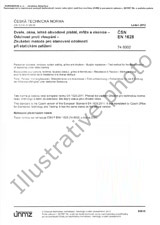We need your consent to use the individual data so that you can see information about your interests, among other things. Click "OK" to give your consent.
ČSN P CEN/TS 16621 (560605)
Food analysis - Determination of benzo[a]pyrene, benz[a]anthracene, chrysene and benzo[b]fluoranthene in foodstuffs by high performance liquid chromatography with fluorescence detection (HPLC-FD)
Automatically translated name:
Food analysis - Determination of benzo [a] pyrene , benzo [ a] anthracene, chrysene and benzo [ b ] fluoranthene in foodstuffs by high performance liquid chromatography with fluorescence detection (HPLC - FD) ( standard for direct use as CSN ).
STANDARD published on 1.8.2015
The information about the standard:
Designation standards: ČSN P CEN/TS 16621
Classification mark: 560605
Catalog number: 97496
Publication date standards: 1.8.2015
SKU: NS-612129
The number of pages: 28
Approximate weight : 84 g (0.19 lbs)
Country: Czech technical standard
Category: Technical standards ČSN
The category - similar standards:
Annotation of standard text ČSN P CEN/TS 16621 (560605):
This Technical Specification specifies a method for the determination of benzo[a]pyrene (BaP) plus benz[a]anthracene (BaA), benzo[b]fluoranthene (BbF) and chrysene (CHR) in several food matrices. The method is based on size exclusion chromatography (SEC) cleanup, followed by quantification with high performance liquid chromatography (HPLC) with programmable fluorescence detection. This method has been in-house validated via the analysis of spiked samples of edible olive oil, fresh mussels, smoked fish, smoked meat products, processed cereal-based foods for young children, infant formulae, chocolate and food supplements (isoflavones) at levels ranging from 0,25 µg/kg to 1,00 µg/kg and from 4,95 µg/kg to 23,53 µg/kg, depending on the Polycyclic Aromatic Hydrocarbon (PAH) or the matrix. This method complies with the performance characteristics specified for BaP, BaA, BbF and CHR in current legislation [3].
The method has been shown to be applicable to a variety of additional matrices as meat products, fresh fish, paprika, roasted coffee, bread, herbs, breakfast cereals, beer, sunflower oil, olives and fried tomato, with a limit of quantification below 0,5 µg/kg.
In addition, the method was tested in-house and shown to be applicable also for the quantification of the other 12 PAHs of the 15+1 EU priority PAHs set (benzo[c]fluorene (BcL), benzo[j]fluoranthene (BjF), benzo[k]fluoranthene (BkF), cyclopenta[cd]pyrene (CPP), dibenz[a,h]anthracene (DhA), dibenzo[a,e]pyrene (DeP), benzo[ghi]perylene (BgP), dibenzo[a,h]pyrene (DhP), dibenzo[a,i]pyrene (DiP), dibenzo[a,l]pyrene (DlP), indeno[1,2,3-cd]pyrene (IcP), 5-methylchrysene (5MC)) in all matrices listed above and at similar level ranges, except for CPP, where a UV detection had to be used with limits of quantification above 8 µg/kg.
For the determination of PAHs in edible fats and oils, two other standards are also available, EN ISO 22959 and EN ISO 15753 (see [1] and [2])
Preview of the standard ČSN P CEN/TS 16621 (560605)
We recommend:
Technical standards updating
Do you want to make sure you use only the valid technical standards?
We can offer you a solution which will provide you a monthly overview concerning the updating of standards which you use.
Would you like to know more? Look at this page.




 Cookies
Cookies
